Student Spotlight: Kaleah Braswell
Contributed by Kaleah Braswell, History Collections Intern

Hello everyone, my name is Kaleah Braswell! I am currently a senior at East Carolina University and plan to graduate with a Bachelor of Science in History Education and a Bachelor of arts in History in May of 2020. This fall, I have been working as an intern for History Collections at Laupus Library under the direction of Ms. Layne Carpenter. Working at Laupus Library has been a terrific experience! My internship included elements such as helping students at the East Carolina University Community School, creating an exhibit concerning a topic of my choice, and processing two archival collections.
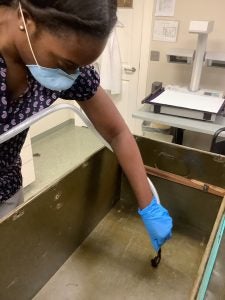
A photo of myself in the process of vacuuming Dr. Andrew Best’s military trunk.
Life at Laupus
Coming to Laupus every Monday and Friday (as well as some Thursdays) provided me with peace of mind. Depending on the task at hand, I start the day by continuing to work on anything that needs completion. I also help Ms. Carpenter with other activities as needed. I spent up to four hours during each visit, totaling the 130 hours needed to complete my internship. One of the other things I was able to help with was artifact cleaning. During my time at Laupus, the Dr. Andrew Best Collection was being processed. Ms. Carpenter gave me the opportunity to use a Nilfisk vacuum to clean out Dr. Best’s military trunk and prepare it for storage.
Exhibit Installation: The Frightful Foursome
At the beginning of the semester, I was informed that my final project would be the creation of an exhibit on a topic of my choice. I have always been interested in the history of medicine, which led me to create an exhibit based on the history and treatment of specific diseases/illnesses. The illnesses I chose were: Typhoid fever, yellow fever, influenza, and dysentery. Coming up with a solid idea wasn’t the hardest part, it was the minute details such as creating labels and organization that proved more difficult. Luckily, Ms. Carpenter showed me how to use software such as Adobe Photoshop and Illustrator to create labels and edit photographs. The use of new software, printing photos to fit the correct size ratio, and learning to use a “finicky” system made this process difficult, but worthwhile. Along with my exhibit, I was given the option to print posters that described my exhibit and provided corresponding information. Ms. Carpenter also helped me with organizing and planning my information so that the size of the exhibit case would accurately illustrate my work.
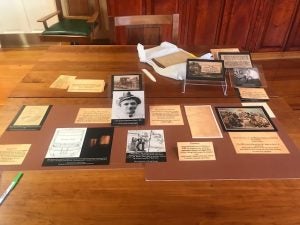
Planning for Exhibit Installation. Ms. Carpenter created a system where cardboard was cut to match the exact dimensions of the actual exhibit case. Using this method, I could practice the permanent placements of my labels/photos/artifacts.
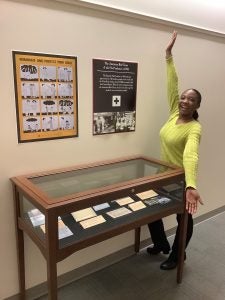
Case Two of my exhibit: The Frightful Foursome.
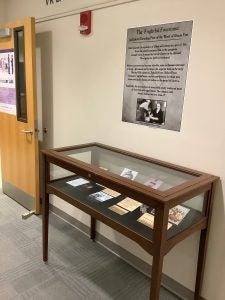
Case One of my exhibit: The Frightful Foursome.
The Pleasures of Processing (Learning Archival Management)
Archival processing during my internship was probably one of my favorite tasks. Organizing is my strong suit, so I was able to create thematic/chronological modes for structuring information. My first collection to organize was a huge compilation of photographs, abstracts, and lectures belonging to the late Dr. Robert S. Fulghum. The second collection I processed included some of the same information, but on a smaller scale, and belonged to Dr. Earl Trevathan Jr. With each collection, I was instructed to create and complete their finding aid using the online software ArchivesSpace. Learning to use this was a little frustrating at first, but after a while, I was able to conquer the different elements of the system. My steps went as follows:
1: Thematically/Chronologically Organizing Information
2: Organizing Information into Corresponding Folders
3: Entering Information into ArchivesSpace
4: Creating Box/Folder Organization Labels
5: Putting the Collection in the Archives/Collection Room for Public Use
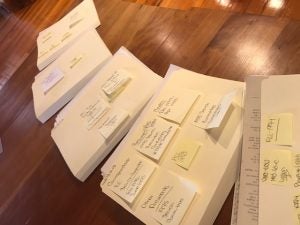


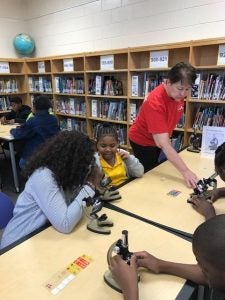
Me assisting a student of the ECU Community School with looking through her microscope. This student even wanted to take a group photo with me towards the end. So sweet!
Conclusion
This internship had become my way of falling back in love with history. After going through a stressful semester, I feel that I can come to Laupus and freely express myself though the interaction with historical materials and exhibit creation. This internship has me thinking about possibly joining a career in public history and historical conservation, even though Secondary History Education is my primary major. Volunteering to inform young children along with the Country Doctor Museum aided in restoring my passion for both history and teaching. Overall, this internship taught me many new skills that prepared me for the real world and my future profession. I am so thankful that I had the chance to participate in this internship.
